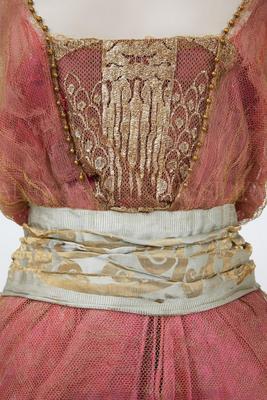Evening belt
Accessories
Inventory number
2020.3.10.30.AC.BL.C1914.ITAuthors:
House of Fortuny (Italian, founded 1906)Mariano FORTUNY (Italian (born Spanish), Granada 1871–1949 Venice)
Description
Large women's belt in pale green colour silk with golden scrolled motifs, and closing with a large bow on the back.It seems, that this sash belongs to the type of Knossos scarves, designed by Mariano FORTUNY at the beginning of his fashion career. The famous Knossos scarf, with its printed designs borrowed from early Corinthian, Cretan, Minoan and Greek decorative vase painting motifs, for the first time was presented in Paris during the ballet for the opening of Countess of Béarn’s private theater on the 29th of March 1906. But it was just the first prototype. It took Mariano Fortuny and his wife and collaborator Henriette Negrin several months of experimenting with fabrics, colors and printed designs to finally launch a collection of 15 different Knossos scarf models. After using the ancient wooden stamp method, which did not give them the expected results, they tried Japanese stencils, "Katagamis". In Katagamis technique the final design was divided into several different stencils, one for each color. In the West, these were replaced by metal or cardboard covers and Fortuny was among the first to use this technique in the West. The names for the models were extracted from a magic formula book: Alblan, Aldou, Algan, Alro, Gandou, Tilleul etc. The collection was presented in Berlin on 24 November 1907, with Ruth St. Denis demonstrating designs to the clients. Later, when Fortuny couple created their most famous Delphos dress, Knossos scarves could be worn in several ways, like a headdress or a gown, or softly wrapped around the body as a sash. The prints used by designer today can be seen in the Palazzo Fortuny museum.
